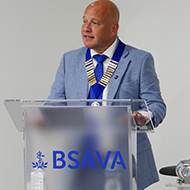3D-printing helps treat dog’s spinal condition
The 3D-printed guide was designed to fit the dog's vertebrae perfectly.
A 3D-printed guide has supported neurology specialists from the Royal (Dick) School of Veterinary Studies as they performed spinal surgery on a one-year-old dog.
The custom-made tool stabilised the dog’s vertebrae, while the surgeons drained the accumulation of spinal fluid.
The one-year-old pug, Geralt, was referred to the neurology service after displaying long-term, non-painful progressive unsteadiness and weakness in his back legs. Geralt also had urinary and faecal incontinence.
After MRI and CT scans, he was diagnosed with spinal arachnoid diverticulum (SAD).
SAD is an abnormal accumulation of cerebrospinal fluid in the meninges – the layers of tissue which surround the spinal cord. The pressure of the fluid compresses the spinal cord and causes severe neurological problems, including faecal and urinary incontinence, limb weakness and ataxia.
The cause of the condition is unknown. There has been some suggestion that it could be linked to genetics in certain breeds, while other theories have pointed to disturbance of the flow of spinal fluid in the vertebrae.
Although SAD is not painful, it is a debilitating condition which can worsen over time, affecting the dog’s quality of life.
The scans also revealed that certain connecting joints needed to maintain the stability of Geralt’s vertebral column were absent.
Using the CT scan images, the specialists were able to commission a 3D-printed guide to fix around the dog’s vertebrae during surgery. The guide matched Geralt’s body perfectly, and had corridors allowing the surgeons to drill and then insert screws with precision.
The surgeons then used bone cement around the screws, which helped fuse the bones to prevent the condition reoccurring.
Geralt recovered well from his surgery. His incontinence has since resolved, and he soon regained full strength in his hind legs.
Dr Aran Nagendran, co-head of the neurology service, said: “We are delighted to offer surgical solutions for animals with SAD and are keen to see how we can adopt the technology of using 3D models for other neurological uses.”
Geralt’s owners, the Di Marcos, said: “We were scared at first, but Geralt immediately responded well after the surgery.
“Now he is happy, he runs and plays with other dogs and enjoys his life to the fullest.”
Image © Shutterstock



 Julian Hoad has been confirmed as the new president of the British Small Animal Veterinary Association (BSAVA), taking over from Carl Gorman.
Julian Hoad has been confirmed as the new president of the British Small Animal Veterinary Association (BSAVA), taking over from Carl Gorman.